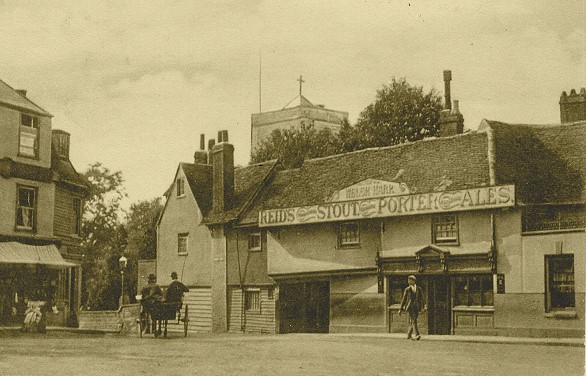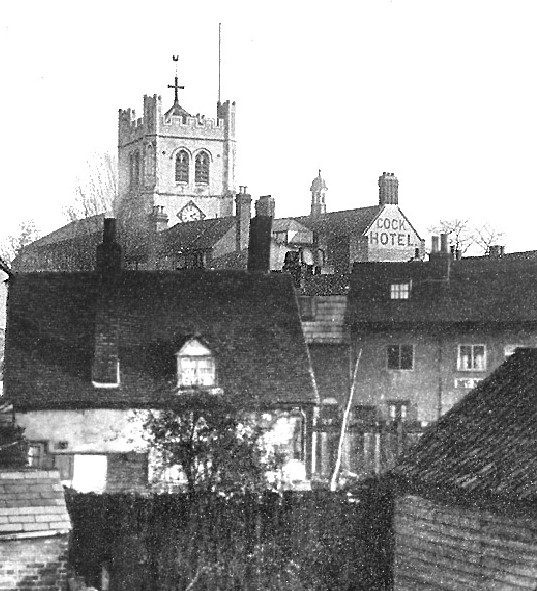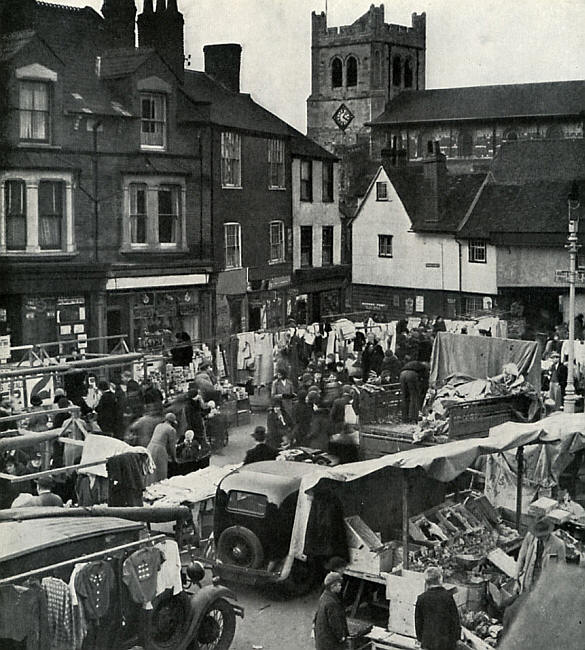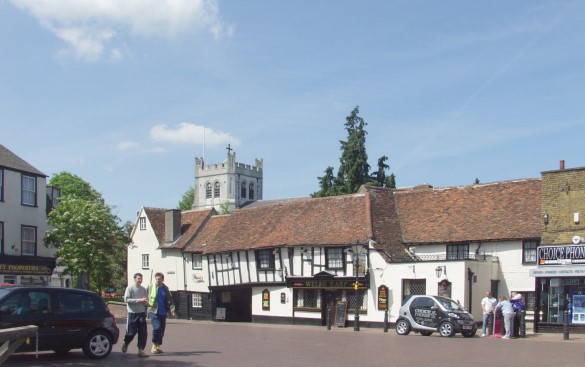Welsh Harp, Market Square, Waltham Abbey, Essex EN9 1DL
Waltham Abbey pub history index
Also known as the Harp; the 1861 lists it as the Harp, corner of Church yard

The Welsh Harp, Waltham Abbey circa 1895

I can now say that WAHS conducted digs in he Romeland in 1973 and 1974, and reports were published in Post-Modern Archaeology vol. 8 and Medieval Archaeology vols. XVIII and XIX. The dig at the Crown took place in 1975, and was reported in Medieval Archaeology XX. I don't think I have copies of these articles to hand.
Regarding the crown's windows, I am sending you another photo, from the WAHS collection. It probably dates to the inter-war years, and is taken from west of the Romeland and shows part of the Crown at centre right. This I think makes it clear that the windows in the pub today must have been replaced after this photo and the postcard photo were taken. This does beg the question why and how a large group of obviously matching yet very old window frames were used (see the modern shots I took), but I think the answer may lie in the destruction of most of Romeland in WW2, which could easily have allowed such windows to be salvaged from one of the ruins. However, if I am right about the 1975 dig being done before the construction of an extension, and considering the fact that my recent photo shows all the front windows to be similar, then I thin it unlikely that spare windows would have been kept in storage from the late 40s until the c.1975 extension, so maybe the present windows were installed c.1975 rather than soon after WW2.
Lastly, I am sending a map I drew of the abbey precinct for a booklet. I have adapted it by colouring the Crown in yellow, the Welsh Harp in green, and the Lychgate House in blue. What I want to draw your attention to is the cloisters north of the pre-dissolution abbey, built by Henry II in 1177. This is an unusual position for cloisters, as they were almost always placed to the south of the main axis, to catch more sunlight and avoid being in the shadow of the choir etc. In the case of Waltham Abbey, it is believed that this north positioning reveals that there wasn't enough space to allow the cloisters to be placed the southerly position. What isn't shown ion this map is the remains of a Saxon cemetery which were discovered during digs in the 1960s and 1970s. This cemetery covered the horizontal rectangle below the K and stretched westwards as far as the SW corner of the present church (the parts still standing are filled in dark grey). The datings of the various burials begin at about the 7th century by the SW corner, and get progressively later the further east we go, up to around the 10th century. The eerie contents of some of these graves were found under the floor of the Welsh Harp during building works in the late 19th century!
Therefore, when the abbey was built in the 1170s, the whole of this area to the south of the building was currently in use as a cemetery and therefore hindered the layout of the abbey. After 1177, perhaps in the 13th or 14th century, Sun Street was laid out partly on this cemetery, suggesting that it had been abandoned by then and the land had become desirable for development, and the market square was also allowed to encroach on the early part of the cemetery near the abbey.
Perhaps only incidentally or perhaps not, the early history of the area marked as L has long been a mystery, until very recently. We know it was developed, including the ornamental moat around its edge, as part of the gardens of Lord Denny's home, Abbey House, which he built from stonework taken from the abbey soon after the Dissolution, which he acquired from Henry VIII. (Abbey House was in turn demolished in the 18th century.) But what was here before the dissolution has always been uncertain, as it lies outside the original precinct walls (marked K). But another member of WAHS recently found a medieval deed which referred to it by a name which I can't remember, and which he translated or took to mean something like 'new cemetery', which if correct would suggest that when the old Saxon cemetery was finally abandoned, perhaps in the 13th or 14th centuries, then this area was designated as its replacement. There has never been any archaeological dig on this site.
Thus we can say that the Welsh Harp probably has a history stretching back to this development, even if the present structure may have replaced an earlier one some centuries later - or maybe the earliest one still stands?
The naming of the Welsh Harp is a local curiosity. There are two theories I know of. The first relies on this town's long association with gunpowder manufacture, and suggests that the pub was the natural meeting place of one of the many bands of soldiers who regularly marched to and from the town in old times - presumably a Welsh regiment. The other, which I favour, relies on the old tradition that Welsh drovers would drive their cattle all the way from Wales to various Essex market towns, where the lush grazing would fatten the cows up and allow premium prices to be made. I have ancestors from near Ware called RIST which I think is a corruption of RICE, and in researching this I found that there is a small but quite noticeable collection of Welsh surnames in and around an area of say 20 miles radius, centred on Bishops Stortford; this can even be seen today by studying phone books for example. Therefore I think it quite plausible that the wives of some Welsh drovers might have brought their harps along with them, perhaps playing them each year for their countryfolk at this pub as the cattle market went on outside, and somehow or other the association stuck. Only guesswork, of course. I note that there is another pub in the market square with an equally unusual name that it has also borne for at least a couple of centuries - the Green Dragon. Did the Welsh bring their mothers-in-law along too?!
The routes taken during the 17th,18th,& 19th centuries drovers attending
Barnet fair which existed for some 500 years, would move any unsold cattle
to the markets and fairs at Romford, Epping ,Chelmsford and Wansted. They
approached Waltham from Bulls Cross along Bullsmore Lane. Cattle moving
south from Peterborough into Hertford would also cross into Essex, at that
point. I am not sure when the Broxbourn bridge was built, but apart from the
Hillyard toll bridge at Tottenham (they avoided toll roads or bridges), it
was the only crossing into Essex in the early period. The crossing at
Fulling Mill and Green Street only appear on the 1810 maps, and not in 1770.
The Welsh drovers were not known for their sobriety, and used inns for
accommodation and refreshment. A Welsh drover was buried in Epping Upland in
1835, and many of them retired to live in Essex.
There is another example of a Welsh Harp pub in London near Kingsbury
(TQ225875). On the 1810 map it is shown as The Harp on the A5 to Edgware,
but became known as the Welsh Harp, because of the involvement of the Welsh
Drovers nearby. The local grazing area was known as Oxgate in 1770, and the
drovers would move their cattle from there to Hampstead and onto Smithfield
market. When the reservoir was built in 1830 it was named the Welsh Harp
after the pub. The drovers had a huge influence on the place names of the
time. I can send you a picture of the pub in 1810 if you wish, along with
any other information you require. **

The Welsh Harp, Waltham Abbey - in 1951
Kindly provided by Colleen

The Welsh Harp, Waltham Abbey in 2005
Most kindly provided by Lawrence Greenall
Residents at this address
The licensee in 1769 was recorded on the Alehouse Recognizances as William Davis, at the Harp, Waltham Holy Cross.
The licensee in 1784 was recorded on the Alehouse Recognizances as John Ives, at the Harp, Waltham Holy Cross.
The licensee in 1801 and 1806 was recorded on the Alehouse Recognizances as David Orme, at the Harp, Waltham Holy Cross.
The licensee in 1810 and 1816 was recorded on the Alehouse Recognizances as John Marton, at the Harp, Waltham Town.
1822/Isaac Baker/../../../Pigot's*
The licensee in 1825 was recorded on the Alehouse Recognizances as Isaac Baker, at the Harp, Waltham Town.
1826/Isaac Baker/../../../Pigot's
1828-9/Isaac Baker/../../../Pigot's
1832-3/Isaac Baker/../../../Pigot's
1839/Isaac Baker/../../../Pigot's
1840/Isaac Baker/../../../Pigot's*
1841/Isaac Baker/Publican/50/Essex/Census
1841/Sarah Baker/../55/../Census
1841/Ellen Coote/../25/Essex/Census
1841/Ellen Coote/../15/Essex/Census
1841/Robert Coote/../7/../Census
1841/John Wareham/../14/Essex/Census
1841/John Curry/Army/30/Ireland/Census
1841/Sarah Curry/../20/../Census
1845/Isaac Baker/../../../Post Office
1848/Isaac Baker/../../../White's
1851/Isaac Baker/../../../Post Office
1851/Isaac Baker/Victualler/59/Waltham Abbey, Essex/Census
1851/Sarah Baker/Wife/57/Kimpton, Hertfordshire/Census
1851/William Allsey/Pot Boy/20/Waltham Abbey, Essex/Census
1851/I. Baker/../../../Kelly's*
1855/I Baker/../../../Post Office
1861/Samuel Holt/Licensed Victualler/44/Odle, Bedfordshire/Census
1861/Susan Holt/Wife/45/Harlington, Bedfordshire/Census
1861/James R Holt/Son/5/Waltham Abbey, Essex/Census
1861/Fanny Bavister/General Servant/16/Chatton, Bedfordshire/Census
1861/Frederick Smith/Ostler/14/Coopersale, Essex/Census
+ Lodgers
1862/William Skinner/../../../Kelly's
1867/William Skinner/../../../Post Office
1870/William Skinner/../../../Kelly's
1871/William Skinner/Licensed Victualler/36/Bedford, Bedfordshire//Census
1871/Sarah Skinner/Wife/36/Luton, Bedfordshire/Census
1871/Elizabeth A Skinner/Daughter/7/Waltham Abbey, Essex/Census
1871/Martha Skinner/Daughter/6/Waltham Abbey, Essex/Census
1871/Alice Skinner/Daughter/3/Waltham Abbey, Essex/Census
1871/Walter R Varney/Potman/18/Loughton, Essex/Census
1871/Ann Tarling/Barmaid/21/Waltham Abbey, Essex/Census
1871/Sarah Tarling/General Servant/13/Waltham Abbey, Essex/Census
1874/William Skinner/../../../Kelly's
1876/William Skinner/../../../Kelly's*
1878/William Skinner/../../../Kelly's
1880/William Skinner/../../../Kelly's*
1881/William Skinner/Licensed Victualler/45/Bedford, Bedford/Census
1881/Sarah Skinner/Wife/45/Luton, Bedford/Census
1881/Elizabeth Agnes Skinner/Daughter, Assistant/17/Waltham Abbey,
Essex/Census
1881/Martha Skinner/Daughter/16/Waltham Abbey, Essex/Census
1881/Alice Skinner/Daughter/13/Waltham Abbey, Essex/Census
1881/Eliza Colverd/General Servant/24/Waltham Abbey, Essex/Census
1881/Benjamin Knightley/Potman/37/Ware, Hertford/Census
1882/William Skinner/../../../Kelly's
1885/William Skinner/../../../Kelly's*
1886/William Skinner/../../../Kelly's
1891/William Skinner/Licensed Victualler/55/Bedford, Bedfordshire/Census
1891/Sarah Skinner/Wife/55/Luton, Bedfordshire/Census
1891/Elizabeth A Skinner/Daughter, Assistant/27/Waltham Abbey, Essex/Census
1891/Martha Skinner/Daughter, Assistant/26/Waltham Abbey, Essex/Census
1891/Alice Skinner/Daughter, Assistant/23/Waltham Abbey, Essex/Census
1891/Elizabeth Rickford/General Servant/20/Waltham Abbey, Essex/Census
1891/Arthur Dobson/Potman/18/Staine, Oxfordshire/Census
1894/William Skinner/../../../Kelly's
September
1897/William Skinner/Outgoing licensee has held the license 35 years without
a complaint/../../Chelmsford Chronicle
September
1897/Herbert Neat Buer/Incoming licensee/../../Chelmsford Chronicle
1898/Herbert Buer/../../../Kelly's
1899/Herbert Buer/../../../Kelly's
1901/William F H Grounds/Licensed Victualler/58/Lothbury, London/Census
1901/Sarah Grounds/Wife/52/Newcastle on Tyne, Northumberland/Census
1901/John A Grounds/Son/13/Harrow Road, London/Census
1901/May Land/Barmaid/18/Norwich, Norfolk/Census
1901/Grace Brightwood/General Servanr/20/Bromley by Bow, London/Census
1901/Arthur E Potter/Son in Law, Labourer in Powder Mills/21/Brompton,
London/Census
1901/Ellen E M Potter/Daughter/18/Grays, Essex/Census
1901/Lydia Potter/Grand Daughter/11 months/Waltham Abbey, Essex/Census
1902/John R. Saunders/../../../Kelly's
1908/Thomas Dennis Allcock/../../../Kelly's
1911/George William Spencer/Licensed Victualler/34/Camberwell/Census
1911/Louisa Annie Spencer/Wife, Assistant/40/Bishops Stortford/Census
1911/Elizabeth Jane Philpot/Servant/15/Waltham Abbey/Census
1911/Albert Lionel Rowe/Boarder, Barber/26/Buckinghamshire/Census
1912/David John Carter/../../../Kelly's
1917/Walter J. Burdon/../../../Kelly's
1925/Arthur Ball/../../../Kelly's
1933/Frederick William Green/../../../Kelly's
1937/Frederick William Green/../../../Kelly's
2018, Welsh Harp Public House, Market Square, Waltham Abbey, Essex EN9 1DL
* Provided by the Pubs, Inns and Taverns Index for England, 1801-1900
** Provided by John Trimmer
PUB HISTORY